Nursing Management of Mr. Ferguson: Assessment 1 Analysis
VerifiedAdded on 2021/10/01
|11
|3166
|72
Report
AI Summary
This report examines the nursing management of Mr. Ferguson, a 76-year-old patient admitted to the Emergency Department with chest heaviness, diaphoresis, shortness of breath, hypertension, and tachycardia. The assignment delves into the pathophysiology of Mr. Ferguson's conditions, including tachycardia, hypertension, and dyspnea, linking them to his past medical history of angina, hypercholesterolemia, and NSTEMI. It then analyzes the pharmacokinetics of the prescribed medications: aspirin, metoprolol, rosuvastatin, and glyceryltrinitrate pump spray, detailing their mechanisms of action and effects. The report further outlines essential nursing management strategies, such as administering beta-blockers and verapamil, performing thorough patient assessments using the PQRST method, and providing physical therapy techniques. Finally, it emphasizes the importance of educating the patient and their family about the medications' contraindications, adverse effects, and appropriate administration guidelines, concluding with a summary of the chronic conditions and the significance of comprehensive care.
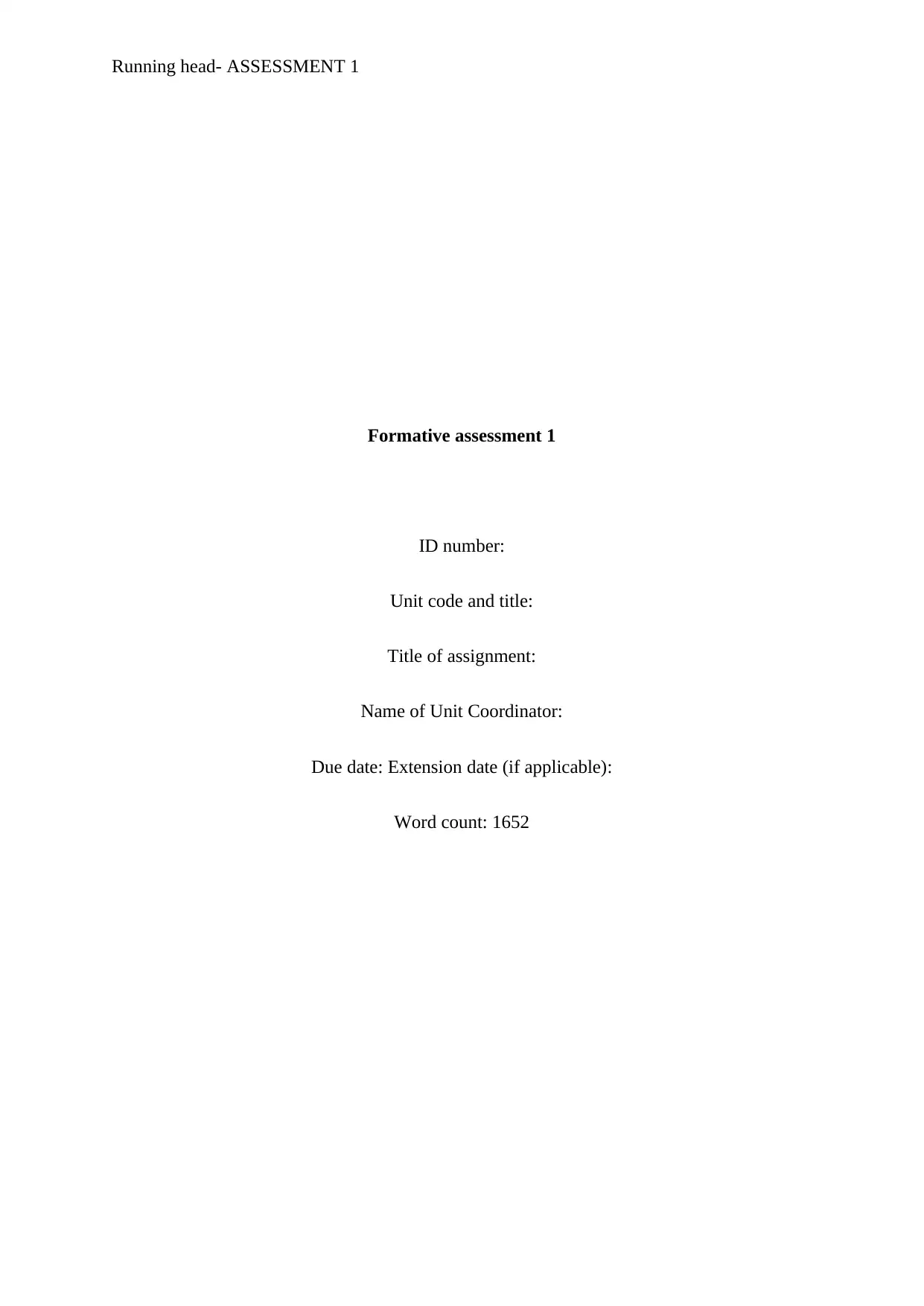
Running head- ASSESSMENT 1
Formative assessment 1
ID number:
Unit code and title:
Title of assignment:
Name of Unit Coordinator:
Due date: Extension date (if applicable):
Word count: 1652
Formative assessment 1
ID number:
Unit code and title:
Title of assignment:
Name of Unit Coordinator:
Due date: Extension date (if applicable):
Word count: 1652
Paraphrase This Document
Need a fresh take? Get an instant paraphrase of this document with our AI Paraphraser
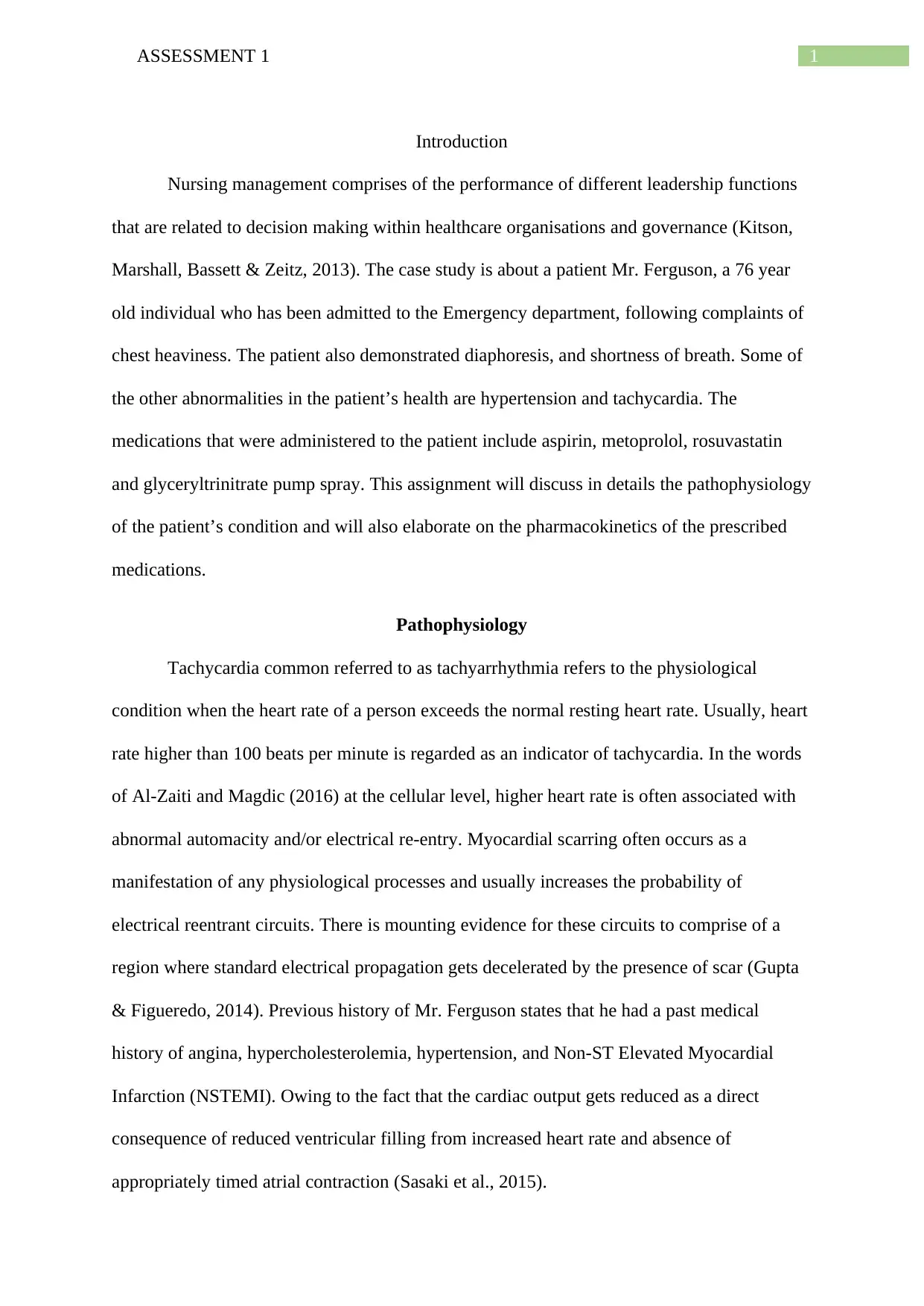
1ASSESSMENT 1
Introduction
Nursing management comprises of the performance of different leadership functions
that are related to decision making within healthcare organisations and governance (Kitson,
Marshall, Bassett & Zeitz, 2013). The case study is about a patient Mr. Ferguson, a 76 year
old individual who has been admitted to the Emergency department, following complaints of
chest heaviness. The patient also demonstrated diaphoresis, and shortness of breath. Some of
the other abnormalities in the patient’s health are hypertension and tachycardia. The
medications that were administered to the patient include aspirin, metoprolol, rosuvastatin
and glyceryltrinitrate pump spray. This assignment will discuss in details the pathophysiology
of the patient’s condition and will also elaborate on the pharmacokinetics of the prescribed
medications.
Pathophysiology
Tachycardia common referred to as tachyarrhythmia refers to the physiological
condition when the heart rate of a person exceeds the normal resting heart rate. Usually, heart
rate higher than 100 beats per minute is regarded as an indicator of tachycardia. In the words
of Al-Zaiti and Magdic (2016) at the cellular level, higher heart rate is often associated with
abnormal automacity and/or electrical re-entry. Myocardial scarring often occurs as a
manifestation of any physiological processes and usually increases the probability of
electrical reentrant circuits. There is mounting evidence for these circuits to comprise of a
region where standard electrical propagation gets decelerated by the presence of scar (Gupta
& Figueredo, 2014). Previous history of Mr. Ferguson states that he had a past medical
history of angina, hypercholesterolemia, hypertension, and Non-ST Elevated Myocardial
Infarction (NSTEMI). Owing to the fact that the cardiac output gets reduced as a direct
consequence of reduced ventricular filling from increased heart rate and absence of
appropriately timed atrial contraction (Sasaki et al., 2015).
Introduction
Nursing management comprises of the performance of different leadership functions
that are related to decision making within healthcare organisations and governance (Kitson,
Marshall, Bassett & Zeitz, 2013). The case study is about a patient Mr. Ferguson, a 76 year
old individual who has been admitted to the Emergency department, following complaints of
chest heaviness. The patient also demonstrated diaphoresis, and shortness of breath. Some of
the other abnormalities in the patient’s health are hypertension and tachycardia. The
medications that were administered to the patient include aspirin, metoprolol, rosuvastatin
and glyceryltrinitrate pump spray. This assignment will discuss in details the pathophysiology
of the patient’s condition and will also elaborate on the pharmacokinetics of the prescribed
medications.
Pathophysiology
Tachycardia common referred to as tachyarrhythmia refers to the physiological
condition when the heart rate of a person exceeds the normal resting heart rate. Usually, heart
rate higher than 100 beats per minute is regarded as an indicator of tachycardia. In the words
of Al-Zaiti and Magdic (2016) at the cellular level, higher heart rate is often associated with
abnormal automacity and/or electrical re-entry. Myocardial scarring often occurs as a
manifestation of any physiological processes and usually increases the probability of
electrical reentrant circuits. There is mounting evidence for these circuits to comprise of a
region where standard electrical propagation gets decelerated by the presence of scar (Gupta
& Figueredo, 2014). Previous history of Mr. Ferguson states that he had a past medical
history of angina, hypercholesterolemia, hypertension, and Non-ST Elevated Myocardial
Infarction (NSTEMI). Owing to the fact that the cardiac output gets reduced as a direct
consequence of reduced ventricular filling from increased heart rate and absence of
appropriately timed atrial contraction (Sasaki et al., 2015).
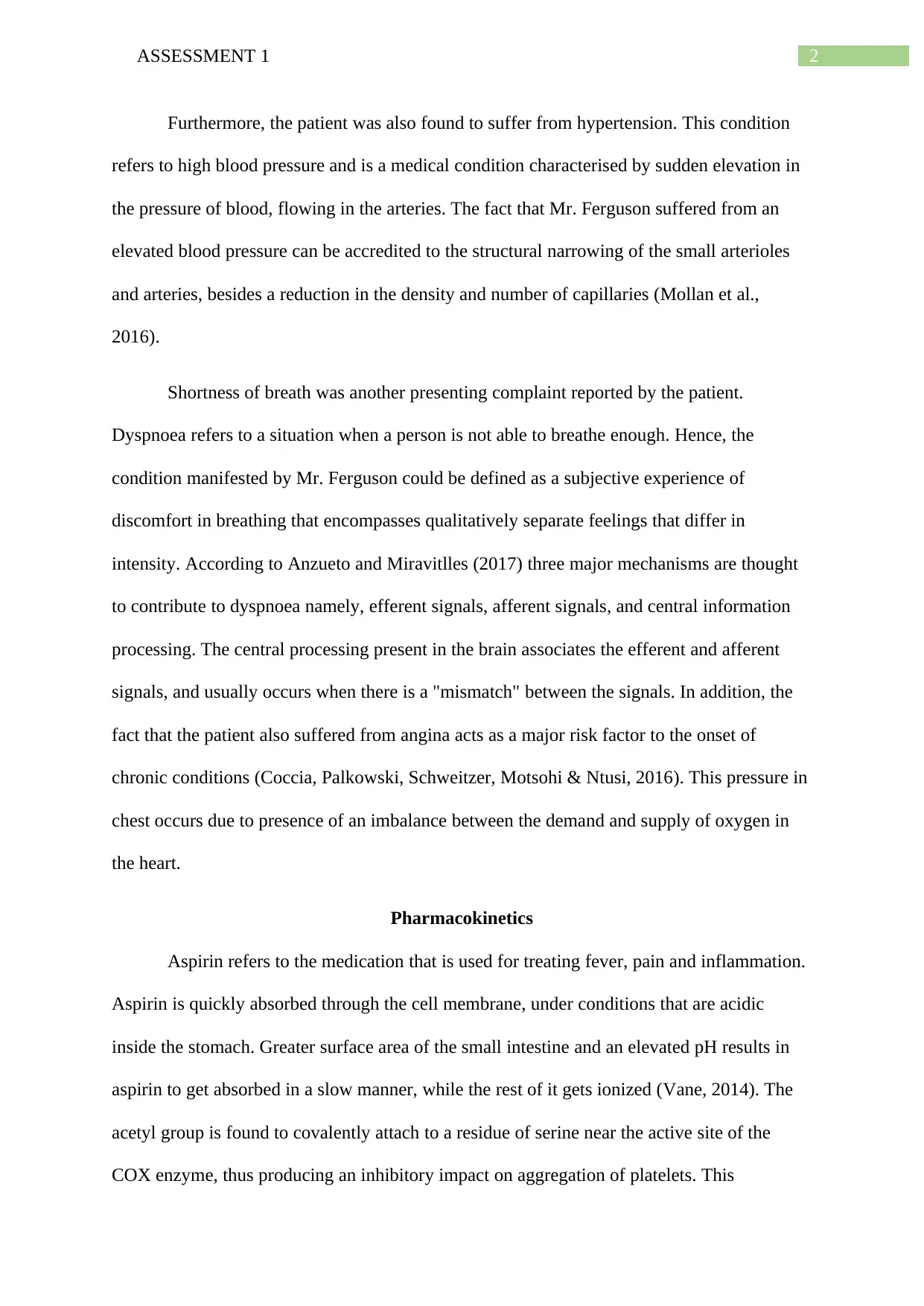
2ASSESSMENT 1
Furthermore, the patient was also found to suffer from hypertension. This condition
refers to high blood pressure and is a medical condition characterised by sudden elevation in
the pressure of blood, flowing in the arteries. The fact that Mr. Ferguson suffered from an
elevated blood pressure can be accredited to the structural narrowing of the small arterioles
and arteries, besides a reduction in the density and number of capillaries (Mollan et al.,
2016).
Shortness of breath was another presenting complaint reported by the patient.
Dyspnoea refers to a situation when a person is not able to breathe enough. Hence, the
condition manifested by Mr. Ferguson could be defined as a subjective experience of
discomfort in breathing that encompasses qualitatively separate feelings that differ in
intensity. According to Anzueto and Miravitlles (2017) three major mechanisms are thought
to contribute to dyspnoea namely, efferent signals, afferent signals, and central information
processing. The central processing present in the brain associates the efferent and afferent
signals, and usually occurs when there is a "mismatch" between the signals. In addition, the
fact that the patient also suffered from angina acts as a major risk factor to the onset of
chronic conditions (Coccia, Palkowski, Schweitzer, Motsohi & Ntusi, 2016). This pressure in
chest occurs due to presence of an imbalance between the demand and supply of oxygen in
the heart.
Pharmacokinetics
Aspirin refers to the medication that is used for treating fever, pain and inflammation.
Aspirin is quickly absorbed through the cell membrane, under conditions that are acidic
inside the stomach. Greater surface area of the small intestine and an elevated pH results in
aspirin to get absorbed in a slow manner, while the rest of it gets ionized (Vane, 2014). The
acetyl group is found to covalently attach to a residue of serine near the active site of the
COX enzyme, thus producing an inhibitory impact on aggregation of platelets. This
Furthermore, the patient was also found to suffer from hypertension. This condition
refers to high blood pressure and is a medical condition characterised by sudden elevation in
the pressure of blood, flowing in the arteries. The fact that Mr. Ferguson suffered from an
elevated blood pressure can be accredited to the structural narrowing of the small arterioles
and arteries, besides a reduction in the density and number of capillaries (Mollan et al.,
2016).
Shortness of breath was another presenting complaint reported by the patient.
Dyspnoea refers to a situation when a person is not able to breathe enough. Hence, the
condition manifested by Mr. Ferguson could be defined as a subjective experience of
discomfort in breathing that encompasses qualitatively separate feelings that differ in
intensity. According to Anzueto and Miravitlles (2017) three major mechanisms are thought
to contribute to dyspnoea namely, efferent signals, afferent signals, and central information
processing. The central processing present in the brain associates the efferent and afferent
signals, and usually occurs when there is a "mismatch" between the signals. In addition, the
fact that the patient also suffered from angina acts as a major risk factor to the onset of
chronic conditions (Coccia, Palkowski, Schweitzer, Motsohi & Ntusi, 2016). This pressure in
chest occurs due to presence of an imbalance between the demand and supply of oxygen in
the heart.
Pharmacokinetics
Aspirin refers to the medication that is used for treating fever, pain and inflammation.
Aspirin is quickly absorbed through the cell membrane, under conditions that are acidic
inside the stomach. Greater surface area of the small intestine and an elevated pH results in
aspirin to get absorbed in a slow manner, while the rest of it gets ionized (Vane, 2014). The
acetyl group is found to covalently attach to a residue of serine near the active site of the
COX enzyme, thus producing an inhibitory impact on aggregation of platelets. This
⊘ This is a preview!⊘
Do you want full access?
Subscribe today to unlock all pages.

Trusted by 1+ million students worldwide
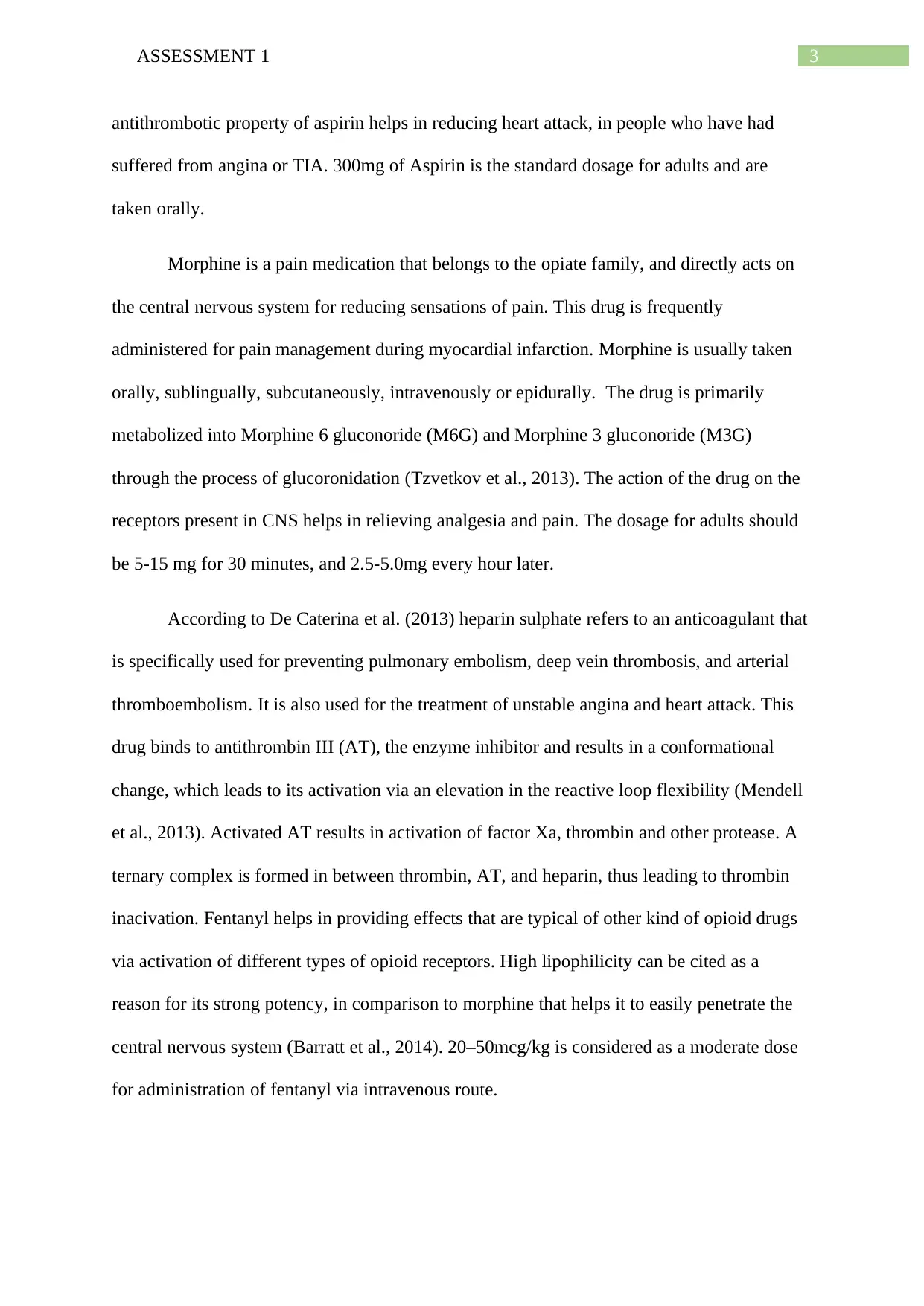
3ASSESSMENT 1
antithrombotic property of aspirin helps in reducing heart attack, in people who have had
suffered from angina or TIA. 300mg of Aspirin is the standard dosage for adults and are
taken orally.
Morphine is a pain medication that belongs to the opiate family, and directly acts on
the central nervous system for reducing sensations of pain. This drug is frequently
administered for pain management during myocardial infarction. Morphine is usually taken
orally, sublingually, subcutaneously, intravenously or epidurally. The drug is primarily
metabolized into Morphine 6 gluconoride (M6G) and Morphine 3 gluconoride (M3G)
through the process of glucoronidation (Tzvetkov et al., 2013). The action of the drug on the
receptors present in CNS helps in relieving analgesia and pain. The dosage for adults should
be 5-15 mg for 30 minutes, and 2.5-5.0mg every hour later.
According to De Caterina et al. (2013) heparin sulphate refers to an anticoagulant that
is specifically used for preventing pulmonary embolism, deep vein thrombosis, and arterial
thromboembolism. It is also used for the treatment of unstable angina and heart attack. This
drug binds to antithrombin III (AT), the enzyme inhibitor and results in a conformational
change, which leads to its activation via an elevation in the reactive loop flexibility (Mendell
et al., 2013). Activated AT results in activation of factor Xa, thrombin and other protease. A
ternary complex is formed in between thrombin, AT, and heparin, thus leading to thrombin
inacivation. Fentanyl helps in providing effects that are typical of other kind of opioid drugs
via activation of different types of opioid receptors. High lipophilicity can be cited as a
reason for its strong potency, in comparison to morphine that helps it to easily penetrate the
central nervous system (Barratt et al., 2014). 20–50mcg/kg is considered as a moderate dose
for administration of fentanyl via intravenous route.
antithrombotic property of aspirin helps in reducing heart attack, in people who have had
suffered from angina or TIA. 300mg of Aspirin is the standard dosage for adults and are
taken orally.
Morphine is a pain medication that belongs to the opiate family, and directly acts on
the central nervous system for reducing sensations of pain. This drug is frequently
administered for pain management during myocardial infarction. Morphine is usually taken
orally, sublingually, subcutaneously, intravenously or epidurally. The drug is primarily
metabolized into Morphine 6 gluconoride (M6G) and Morphine 3 gluconoride (M3G)
through the process of glucoronidation (Tzvetkov et al., 2013). The action of the drug on the
receptors present in CNS helps in relieving analgesia and pain. The dosage for adults should
be 5-15 mg for 30 minutes, and 2.5-5.0mg every hour later.
According to De Caterina et al. (2013) heparin sulphate refers to an anticoagulant that
is specifically used for preventing pulmonary embolism, deep vein thrombosis, and arterial
thromboembolism. It is also used for the treatment of unstable angina and heart attack. This
drug binds to antithrombin III (AT), the enzyme inhibitor and results in a conformational
change, which leads to its activation via an elevation in the reactive loop flexibility (Mendell
et al., 2013). Activated AT results in activation of factor Xa, thrombin and other protease. A
ternary complex is formed in between thrombin, AT, and heparin, thus leading to thrombin
inacivation. Fentanyl helps in providing effects that are typical of other kind of opioid drugs
via activation of different types of opioid receptors. High lipophilicity can be cited as a
reason for its strong potency, in comparison to morphine that helps it to easily penetrate the
central nervous system (Barratt et al., 2014). 20–50mcg/kg is considered as a moderate dose
for administration of fentanyl via intravenous route.
Paraphrase This Document
Need a fresh take? Get an instant paraphrase of this document with our AI Paraphraser
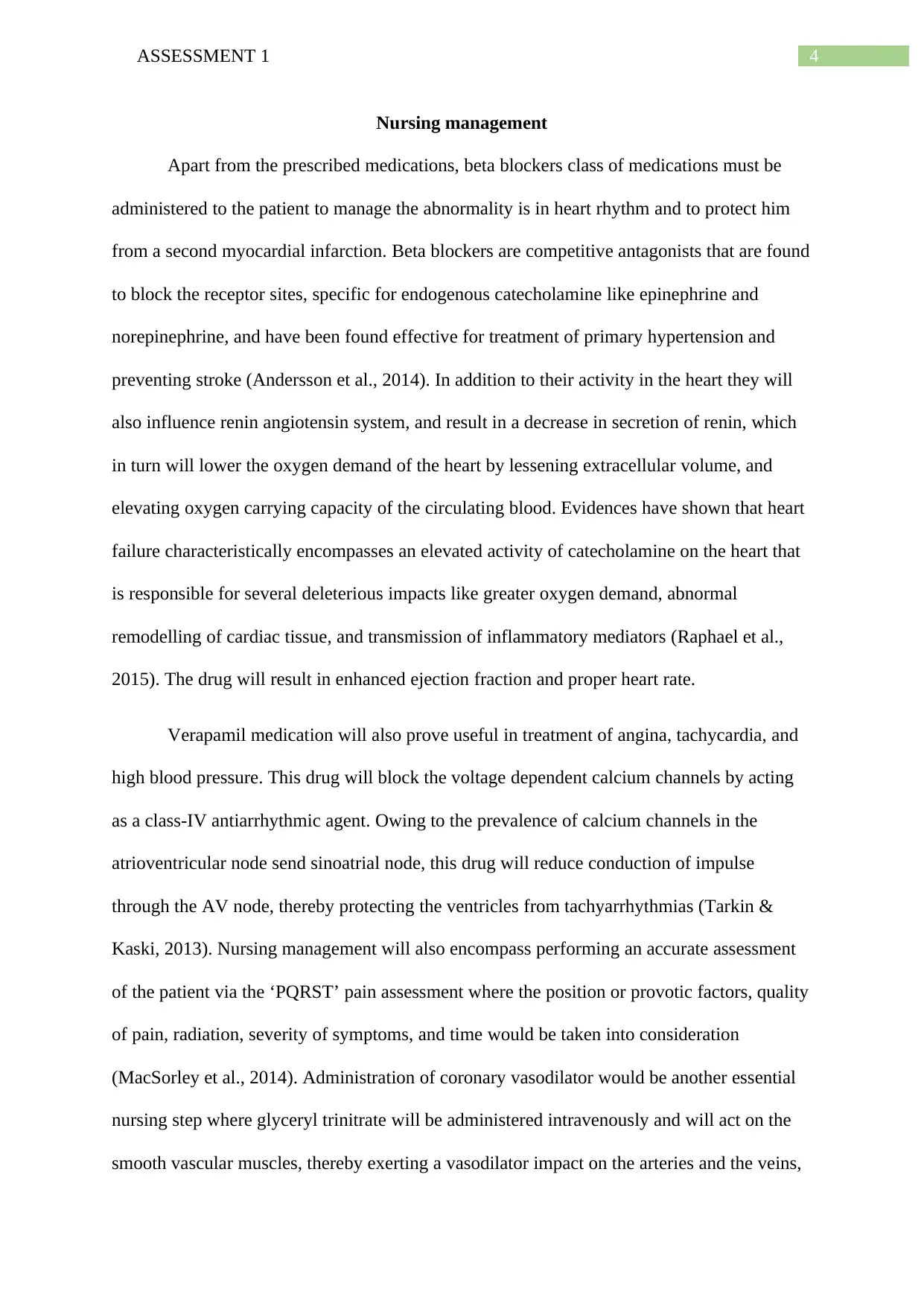
4ASSESSMENT 1
Nursing management
Apart from the prescribed medications, beta blockers class of medications must be
administered to the patient to manage the abnormality is in heart rhythm and to protect him
from a second myocardial infarction. Beta blockers are competitive antagonists that are found
to block the receptor sites, specific for endogenous catecholamine like epinephrine and
norepinephrine, and have been found effective for treatment of primary hypertension and
preventing stroke (Andersson et al., 2014). In addition to their activity in the heart they will
also influence renin angiotensin system, and result in a decrease in secretion of renin, which
in turn will lower the oxygen demand of the heart by lessening extracellular volume, and
elevating oxygen carrying capacity of the circulating blood. Evidences have shown that heart
failure characteristically encompasses an elevated activity of catecholamine on the heart that
is responsible for several deleterious impacts like greater oxygen demand, abnormal
remodelling of cardiac tissue, and transmission of inflammatory mediators (Raphael et al.,
2015). The drug will result in enhanced ejection fraction and proper heart rate.
Verapamil medication will also prove useful in treatment of angina, tachycardia, and
high blood pressure. This drug will block the voltage dependent calcium channels by acting
as a class-IV antiarrhythmic agent. Owing to the prevalence of calcium channels in the
atrioventricular node send sinoatrial node, this drug will reduce conduction of impulse
through the AV node, thereby protecting the ventricles from tachyarrhythmias (Tarkin &
Kaski, 2013). Nursing management will also encompass performing an accurate assessment
of the patient via the ‘PQRST’ pain assessment where the position or provotic factors, quality
of pain, radiation, severity of symptoms, and time would be taken into consideration
(MacSorley et al., 2014). Administration of coronary vasodilator would be another essential
nursing step where glyceryl trinitrate will be administered intravenously and will act on the
smooth vascular muscles, thereby exerting a vasodilator impact on the arteries and the veins,
Nursing management
Apart from the prescribed medications, beta blockers class of medications must be
administered to the patient to manage the abnormality is in heart rhythm and to protect him
from a second myocardial infarction. Beta blockers are competitive antagonists that are found
to block the receptor sites, specific for endogenous catecholamine like epinephrine and
norepinephrine, and have been found effective for treatment of primary hypertension and
preventing stroke (Andersson et al., 2014). In addition to their activity in the heart they will
also influence renin angiotensin system, and result in a decrease in secretion of renin, which
in turn will lower the oxygen demand of the heart by lessening extracellular volume, and
elevating oxygen carrying capacity of the circulating blood. Evidences have shown that heart
failure characteristically encompasses an elevated activity of catecholamine on the heart that
is responsible for several deleterious impacts like greater oxygen demand, abnormal
remodelling of cardiac tissue, and transmission of inflammatory mediators (Raphael et al.,
2015). The drug will result in enhanced ejection fraction and proper heart rate.
Verapamil medication will also prove useful in treatment of angina, tachycardia, and
high blood pressure. This drug will block the voltage dependent calcium channels by acting
as a class-IV antiarrhythmic agent. Owing to the prevalence of calcium channels in the
atrioventricular node send sinoatrial node, this drug will reduce conduction of impulse
through the AV node, thereby protecting the ventricles from tachyarrhythmias (Tarkin &
Kaski, 2013). Nursing management will also encompass performing an accurate assessment
of the patient via the ‘PQRST’ pain assessment where the position or provotic factors, quality
of pain, radiation, severity of symptoms, and time would be taken into consideration
(MacSorley et al., 2014). Administration of coronary vasodilator would be another essential
nursing step where glyceryl trinitrate will be administered intravenously and will act on the
smooth vascular muscles, thereby exerting a vasodilator impact on the arteries and the veins,
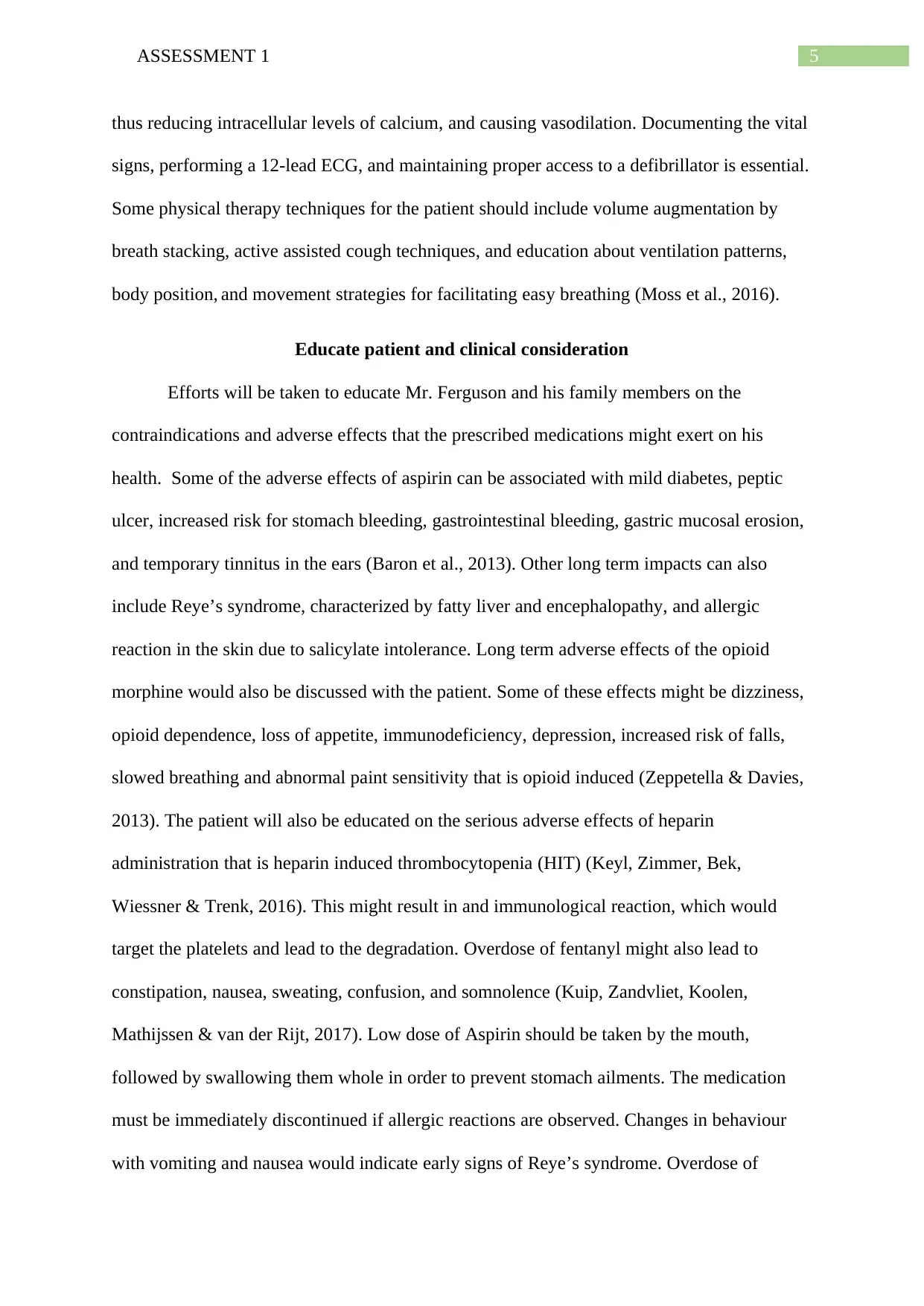
5ASSESSMENT 1
thus reducing intracellular levels of calcium, and causing vasodilation. Documenting the vital
signs, performing a 12-lead ECG, and maintaining proper access to a defibrillator is essential.
Some physical therapy techniques for the patient should include volume augmentation by
breath stacking, active assisted cough techniques, and education about ventilation patterns,
body position, and movement strategies for facilitating easy breathing (Moss et al., 2016).
Educate patient and clinical consideration
Efforts will be taken to educate Mr. Ferguson and his family members on the
contraindications and adverse effects that the prescribed medications might exert on his
health. Some of the adverse effects of aspirin can be associated with mild diabetes, peptic
ulcer, increased risk for stomach bleeding, gastrointestinal bleeding, gastric mucosal erosion,
and temporary tinnitus in the ears (Baron et al., 2013). Other long term impacts can also
include Reye’s syndrome, characterized by fatty liver and encephalopathy, and allergic
reaction in the skin due to salicylate intolerance. Long term adverse effects of the opioid
morphine would also be discussed with the patient. Some of these effects might be dizziness,
opioid dependence, loss of appetite, immunodeficiency, depression, increased risk of falls,
slowed breathing and abnormal paint sensitivity that is opioid induced (Zeppetella & Davies,
2013). The patient will also be educated on the serious adverse effects of heparin
administration that is heparin induced thrombocytopenia (HIT) (Keyl, Zimmer, Bek,
Wiessner & Trenk, 2016). This might result in and immunological reaction, which would
target the platelets and lead to the degradation. Overdose of fentanyl might also lead to
constipation, nausea, sweating, confusion, and somnolence (Kuip, Zandvliet, Koolen,
Mathijssen & van der Rijt, 2017). Low dose of Aspirin should be taken by the mouth,
followed by swallowing them whole in order to prevent stomach ailments. The medication
must be immediately discontinued if allergic reactions are observed. Changes in behaviour
with vomiting and nausea would indicate early signs of Reye’s syndrome. Overdose of
thus reducing intracellular levels of calcium, and causing vasodilation. Documenting the vital
signs, performing a 12-lead ECG, and maintaining proper access to a defibrillator is essential.
Some physical therapy techniques for the patient should include volume augmentation by
breath stacking, active assisted cough techniques, and education about ventilation patterns,
body position, and movement strategies for facilitating easy breathing (Moss et al., 2016).
Educate patient and clinical consideration
Efforts will be taken to educate Mr. Ferguson and his family members on the
contraindications and adverse effects that the prescribed medications might exert on his
health. Some of the adverse effects of aspirin can be associated with mild diabetes, peptic
ulcer, increased risk for stomach bleeding, gastrointestinal bleeding, gastric mucosal erosion,
and temporary tinnitus in the ears (Baron et al., 2013). Other long term impacts can also
include Reye’s syndrome, characterized by fatty liver and encephalopathy, and allergic
reaction in the skin due to salicylate intolerance. Long term adverse effects of the opioid
morphine would also be discussed with the patient. Some of these effects might be dizziness,
opioid dependence, loss of appetite, immunodeficiency, depression, increased risk of falls,
slowed breathing and abnormal paint sensitivity that is opioid induced (Zeppetella & Davies,
2013). The patient will also be educated on the serious adverse effects of heparin
administration that is heparin induced thrombocytopenia (HIT) (Keyl, Zimmer, Bek,
Wiessner & Trenk, 2016). This might result in and immunological reaction, which would
target the platelets and lead to the degradation. Overdose of fentanyl might also lead to
constipation, nausea, sweating, confusion, and somnolence (Kuip, Zandvliet, Koolen,
Mathijssen & van der Rijt, 2017). Low dose of Aspirin should be taken by the mouth,
followed by swallowing them whole in order to prevent stomach ailments. The medication
must be immediately discontinued if allergic reactions are observed. Changes in behaviour
with vomiting and nausea would indicate early signs of Reye’s syndrome. Overdose of
⊘ This is a preview!⊘
Do you want full access?
Subscribe today to unlock all pages.

Trusted by 1+ million students worldwide
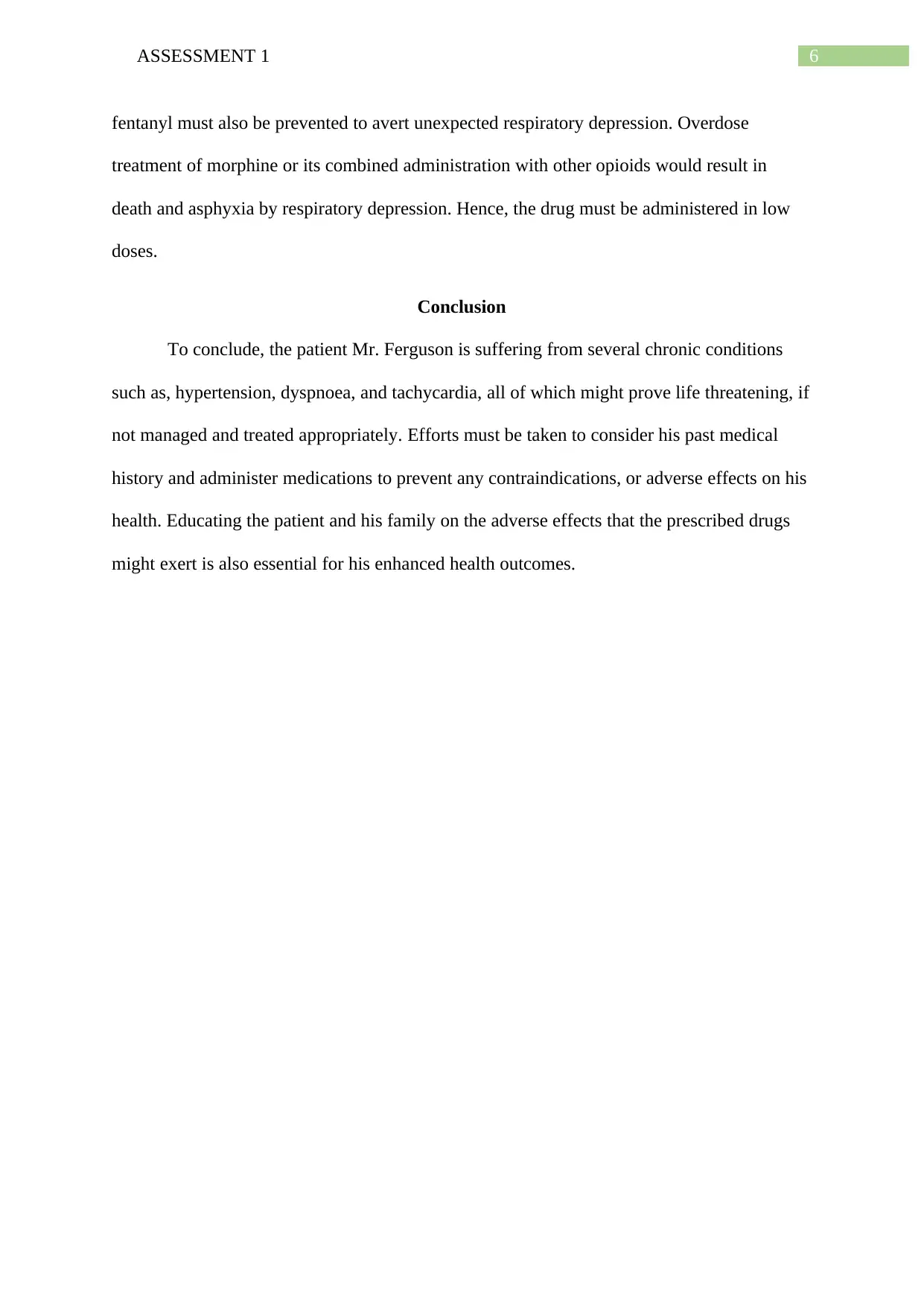
6ASSESSMENT 1
fentanyl must also be prevented to avert unexpected respiratory depression. Overdose
treatment of morphine or its combined administration with other opioids would result in
death and asphyxia by respiratory depression. Hence, the drug must be administered in low
doses.
Conclusion
To conclude, the patient Mr. Ferguson is suffering from several chronic conditions
such as, hypertension, dyspnoea, and tachycardia, all of which might prove life threatening, if
not managed and treated appropriately. Efforts must be taken to consider his past medical
history and administer medications to prevent any contraindications, or adverse effects on his
health. Educating the patient and his family on the adverse effects that the prescribed drugs
might exert is also essential for his enhanced health outcomes.
fentanyl must also be prevented to avert unexpected respiratory depression. Overdose
treatment of morphine or its combined administration with other opioids would result in
death and asphyxia by respiratory depression. Hence, the drug must be administered in low
doses.
Conclusion
To conclude, the patient Mr. Ferguson is suffering from several chronic conditions
such as, hypertension, dyspnoea, and tachycardia, all of which might prove life threatening, if
not managed and treated appropriately. Efforts must be taken to consider his past medical
history and administer medications to prevent any contraindications, or adverse effects on his
health. Educating the patient and his family on the adverse effects that the prescribed drugs
might exert is also essential for his enhanced health outcomes.
Paraphrase This Document
Need a fresh take? Get an instant paraphrase of this document with our AI Paraphraser
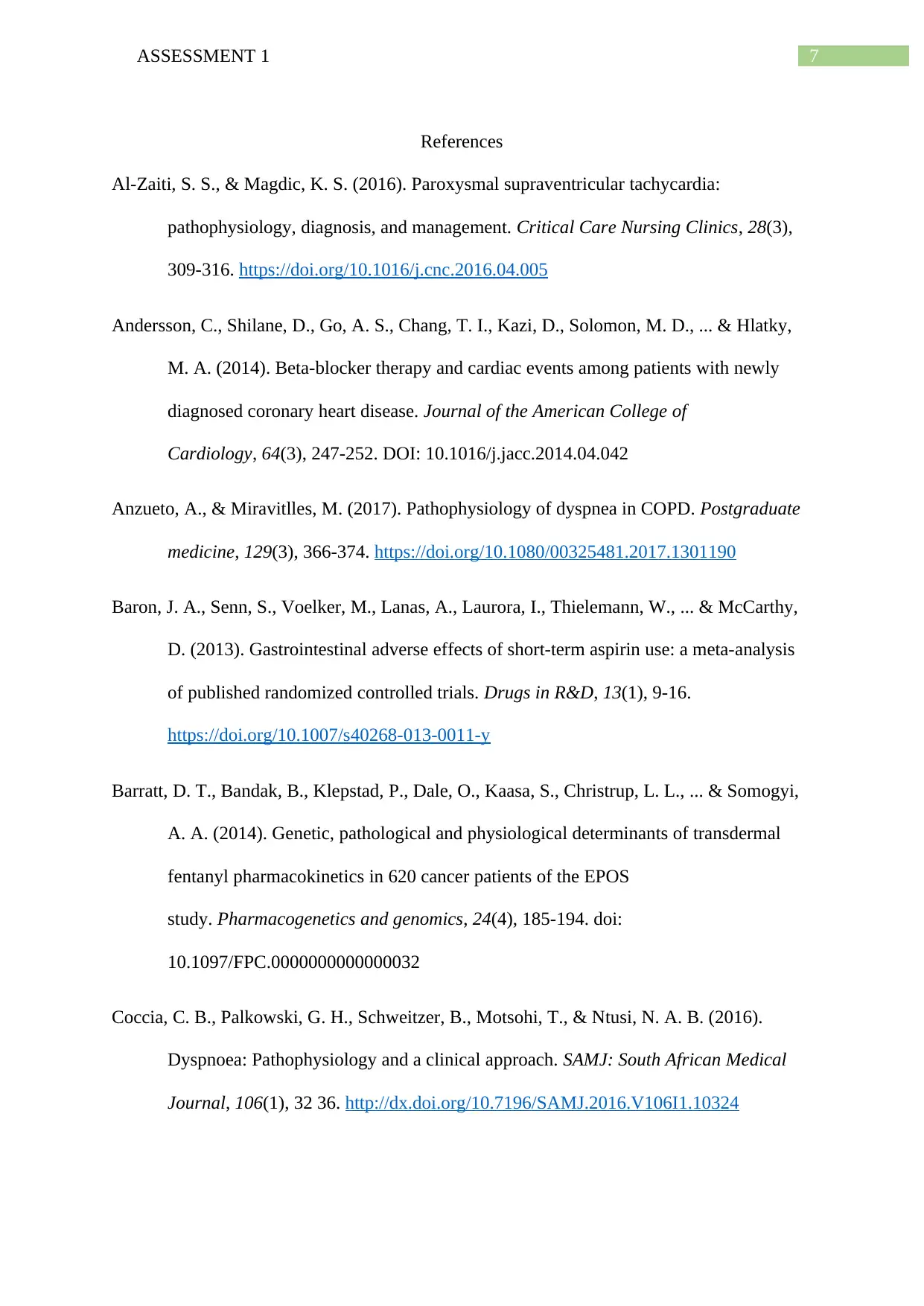
7ASSESSMENT 1
References
Al-Zaiti, S. S., & Magdic, K. S. (2016). Paroxysmal supraventricular tachycardia:
pathophysiology, diagnosis, and management. Critical Care Nursing Clinics, 28(3),
309-316. https://doi.org/10.1016/j.cnc.2016.04.005
Andersson, C., Shilane, D., Go, A. S., Chang, T. I., Kazi, D., Solomon, M. D., ... & Hlatky,
M. A. (2014). Beta-blocker therapy and cardiac events among patients with newly
diagnosed coronary heart disease. Journal of the American College of
Cardiology, 64(3), 247-252. DOI: 10.1016/j.jacc.2014.04.042
Anzueto, A., & Miravitlles, M. (2017). Pathophysiology of dyspnea in COPD. Postgraduate
medicine, 129(3), 366-374. https://doi.org/10.1080/00325481.2017.1301190
Baron, J. A., Senn, S., Voelker, M., Lanas, A., Laurora, I., Thielemann, W., ... & McCarthy,
D. (2013). Gastrointestinal adverse effects of short-term aspirin use: a meta-analysis
of published randomized controlled trials. Drugs in R&D, 13(1), 9-16.
https://doi.org/10.1007/s40268-013-0011-y
Barratt, D. T., Bandak, B., Klepstad, P., Dale, O., Kaasa, S., Christrup, L. L., ... & Somogyi,
A. A. (2014). Genetic, pathological and physiological determinants of transdermal
fentanyl pharmacokinetics in 620 cancer patients of the EPOS
study. Pharmacogenetics and genomics, 24(4), 185-194. doi:
10.1097/FPC.0000000000000032
Coccia, C. B., Palkowski, G. H., Schweitzer, B., Motsohi, T., & Ntusi, N. A. B. (2016).
Dyspnoea: Pathophysiology and a clinical approach. SAMJ: South African Medical
Journal, 106(1), 32 36. http://dx.doi.org/10.7196/SAMJ.2016.V106I1.10324
References
Al-Zaiti, S. S., & Magdic, K. S. (2016). Paroxysmal supraventricular tachycardia:
pathophysiology, diagnosis, and management. Critical Care Nursing Clinics, 28(3),
309-316. https://doi.org/10.1016/j.cnc.2016.04.005
Andersson, C., Shilane, D., Go, A. S., Chang, T. I., Kazi, D., Solomon, M. D., ... & Hlatky,
M. A. (2014). Beta-blocker therapy and cardiac events among patients with newly
diagnosed coronary heart disease. Journal of the American College of
Cardiology, 64(3), 247-252. DOI: 10.1016/j.jacc.2014.04.042
Anzueto, A., & Miravitlles, M. (2017). Pathophysiology of dyspnea in COPD. Postgraduate
medicine, 129(3), 366-374. https://doi.org/10.1080/00325481.2017.1301190
Baron, J. A., Senn, S., Voelker, M., Lanas, A., Laurora, I., Thielemann, W., ... & McCarthy,
D. (2013). Gastrointestinal adverse effects of short-term aspirin use: a meta-analysis
of published randomized controlled trials. Drugs in R&D, 13(1), 9-16.
https://doi.org/10.1007/s40268-013-0011-y
Barratt, D. T., Bandak, B., Klepstad, P., Dale, O., Kaasa, S., Christrup, L. L., ... & Somogyi,
A. A. (2014). Genetic, pathological and physiological determinants of transdermal
fentanyl pharmacokinetics in 620 cancer patients of the EPOS
study. Pharmacogenetics and genomics, 24(4), 185-194. doi:
10.1097/FPC.0000000000000032
Coccia, C. B., Palkowski, G. H., Schweitzer, B., Motsohi, T., & Ntusi, N. A. B. (2016).
Dyspnoea: Pathophysiology and a clinical approach. SAMJ: South African Medical
Journal, 106(1), 32 36. http://dx.doi.org/10.7196/SAMJ.2016.V106I1.10324
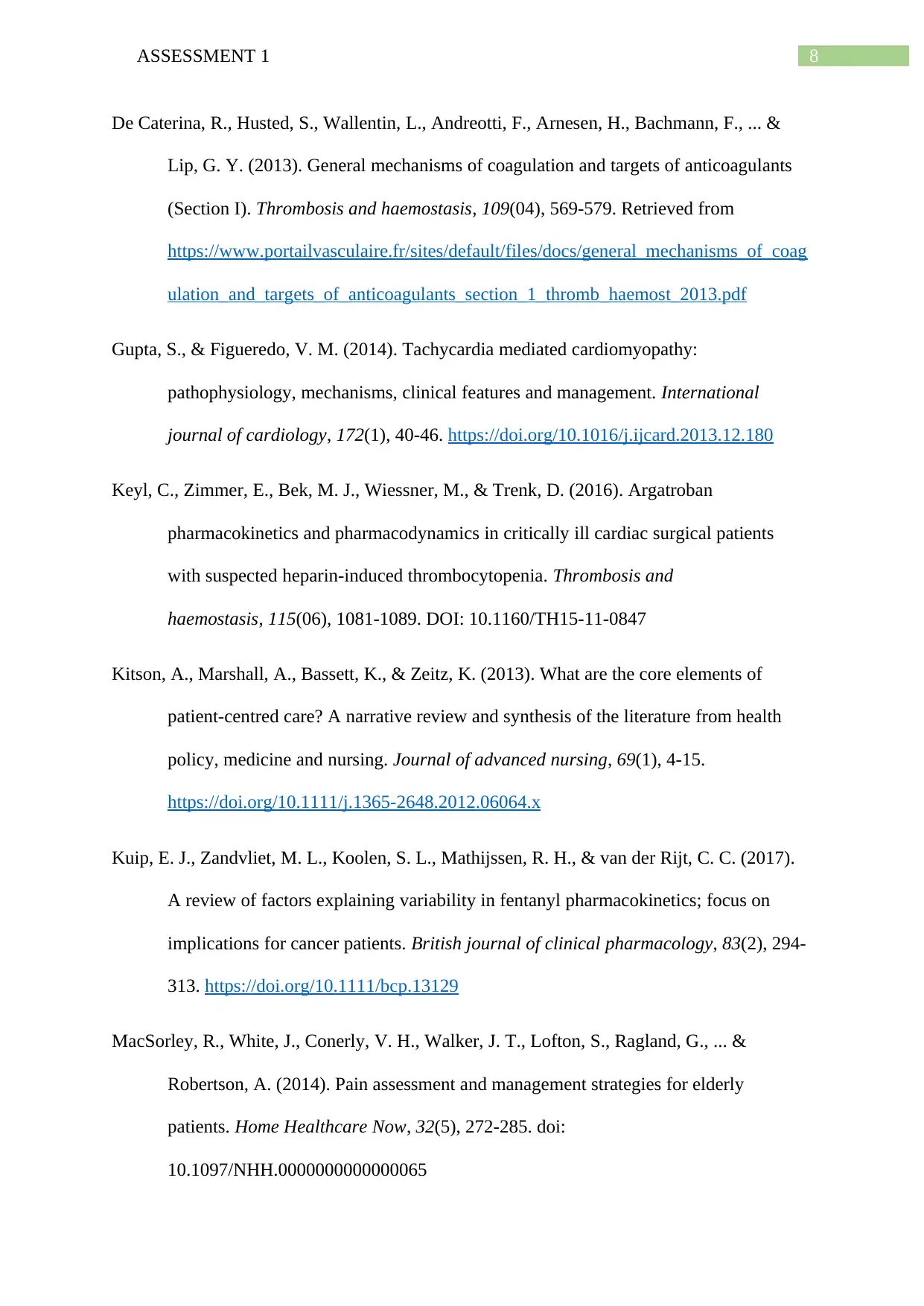
8ASSESSMENT 1
De Caterina, R., Husted, S., Wallentin, L., Andreotti, F., Arnesen, H., Bachmann, F., ... &
Lip, G. Y. (2013). General mechanisms of coagulation and targets of anticoagulants
(Section I). Thrombosis and haemostasis, 109(04), 569-579. Retrieved from
https://www.portailvasculaire.fr/sites/default/files/docs/general_mechanisms_of_coag
ulation_and_targets_of_anticoagulants_section_1_thromb_haemost_2013.pdf
Gupta, S., & Figueredo, V. M. (2014). Tachycardia mediated cardiomyopathy:
pathophysiology, mechanisms, clinical features and management. International
journal of cardiology, 172(1), 40-46. https://doi.org/10.1016/j.ijcard.2013.12.180
Keyl, C., Zimmer, E., Bek, M. J., Wiessner, M., & Trenk, D. (2016). Argatroban
pharmacokinetics and pharmacodynamics in critically ill cardiac surgical patients
with suspected heparin-induced thrombocytopenia. Thrombosis and
haemostasis, 115(06), 1081-1089. DOI: 10.1160/TH15-11-0847
Kitson, A., Marshall, A., Bassett, K., & Zeitz, K. (2013). What are the core elements of
patient‐centred care? A narrative review and synthesis of the literature from health
policy, medicine and nursing. Journal of advanced nursing, 69(1), 4-15.
https://doi.org/10.1111/j.1365-2648.2012.06064.x
Kuip, E. J., Zandvliet, M. L., Koolen, S. L., Mathijssen, R. H., & van der Rijt, C. C. (2017).
A review of factors explaining variability in fentanyl pharmacokinetics; focus on
implications for cancer patients. British journal of clinical pharmacology, 83(2), 294-
313. https://doi.org/10.1111/bcp.13129
MacSorley, R., White, J., Conerly, V. H., Walker, J. T., Lofton, S., Ragland, G., ... &
Robertson, A. (2014). Pain assessment and management strategies for elderly
patients. Home Healthcare Now, 32(5), 272-285. doi:
10.1097/NHH.0000000000000065
De Caterina, R., Husted, S., Wallentin, L., Andreotti, F., Arnesen, H., Bachmann, F., ... &
Lip, G. Y. (2013). General mechanisms of coagulation and targets of anticoagulants
(Section I). Thrombosis and haemostasis, 109(04), 569-579. Retrieved from
https://www.portailvasculaire.fr/sites/default/files/docs/general_mechanisms_of_coag
ulation_and_targets_of_anticoagulants_section_1_thromb_haemost_2013.pdf
Gupta, S., & Figueredo, V. M. (2014). Tachycardia mediated cardiomyopathy:
pathophysiology, mechanisms, clinical features and management. International
journal of cardiology, 172(1), 40-46. https://doi.org/10.1016/j.ijcard.2013.12.180
Keyl, C., Zimmer, E., Bek, M. J., Wiessner, M., & Trenk, D. (2016). Argatroban
pharmacokinetics and pharmacodynamics in critically ill cardiac surgical patients
with suspected heparin-induced thrombocytopenia. Thrombosis and
haemostasis, 115(06), 1081-1089. DOI: 10.1160/TH15-11-0847
Kitson, A., Marshall, A., Bassett, K., & Zeitz, K. (2013). What are the core elements of
patient‐centred care? A narrative review and synthesis of the literature from health
policy, medicine and nursing. Journal of advanced nursing, 69(1), 4-15.
https://doi.org/10.1111/j.1365-2648.2012.06064.x
Kuip, E. J., Zandvliet, M. L., Koolen, S. L., Mathijssen, R. H., & van der Rijt, C. C. (2017).
A review of factors explaining variability in fentanyl pharmacokinetics; focus on
implications for cancer patients. British journal of clinical pharmacology, 83(2), 294-
313. https://doi.org/10.1111/bcp.13129
MacSorley, R., White, J., Conerly, V. H., Walker, J. T., Lofton, S., Ragland, G., ... &
Robertson, A. (2014). Pain assessment and management strategies for elderly
patients. Home Healthcare Now, 32(5), 272-285. doi:
10.1097/NHH.0000000000000065
⊘ This is a preview!⊘
Do you want full access?
Subscribe today to unlock all pages.

Trusted by 1+ million students worldwide
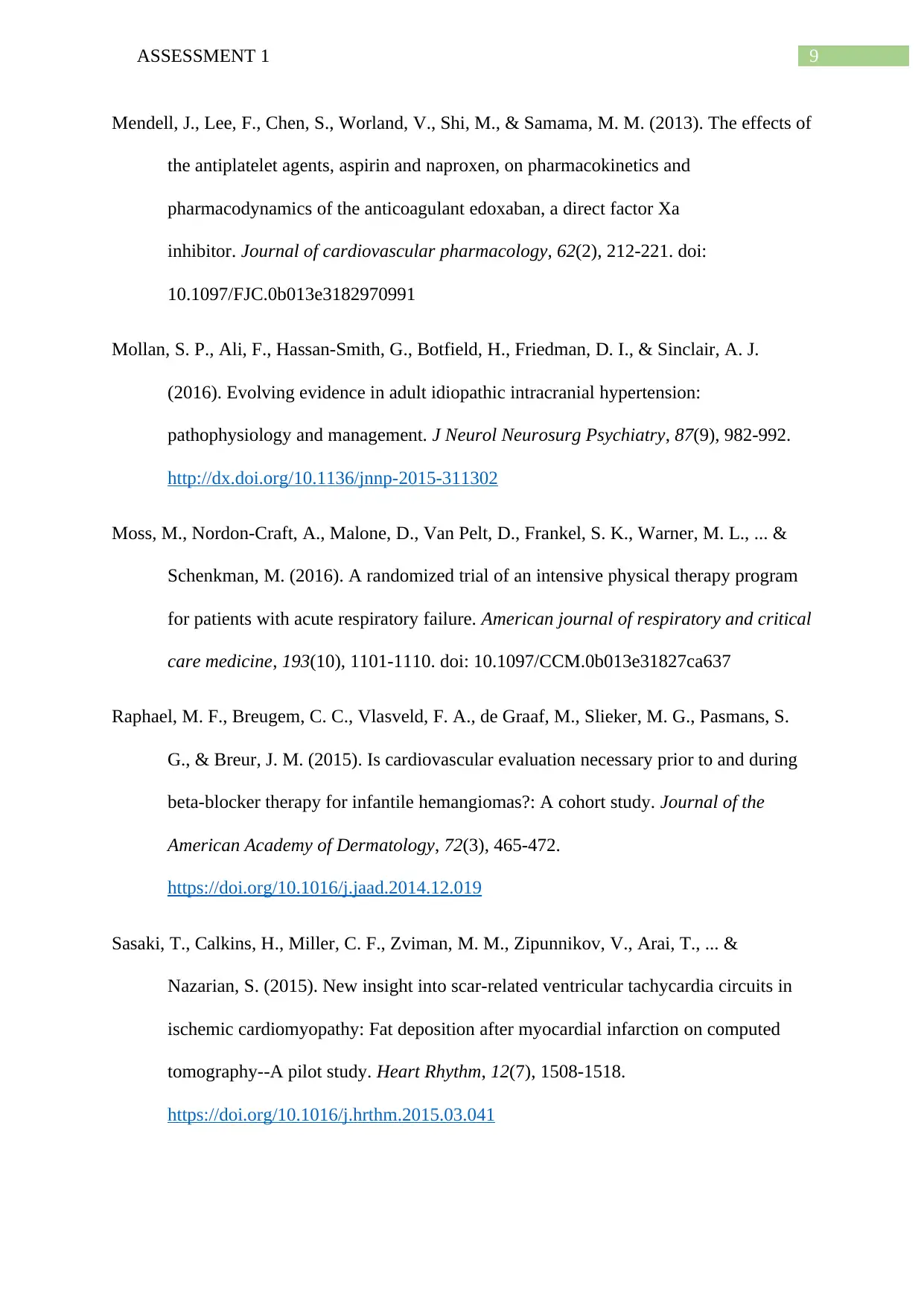
9ASSESSMENT 1
Mendell, J., Lee, F., Chen, S., Worland, V., Shi, M., & Samama, M. M. (2013). The effects of
the antiplatelet agents, aspirin and naproxen, on pharmacokinetics and
pharmacodynamics of the anticoagulant edoxaban, a direct factor Xa
inhibitor. Journal of cardiovascular pharmacology, 62(2), 212-221. doi:
10.1097/FJC.0b013e3182970991
Mollan, S. P., Ali, F., Hassan-Smith, G., Botfield, H., Friedman, D. I., & Sinclair, A. J.
(2016). Evolving evidence in adult idiopathic intracranial hypertension:
pathophysiology and management. J Neurol Neurosurg Psychiatry, 87(9), 982-992.
http://dx.doi.org/10.1136/jnnp-2015-311302
Moss, M., Nordon-Craft, A., Malone, D., Van Pelt, D., Frankel, S. K., Warner, M. L., ... &
Schenkman, M. (2016). A randomized trial of an intensive physical therapy program
for patients with acute respiratory failure. American journal of respiratory and critical
care medicine, 193(10), 1101-1110. doi: 10.1097/CCM.0b013e31827ca637
Raphael, M. F., Breugem, C. C., Vlasveld, F. A., de Graaf, M., Slieker, M. G., Pasmans, S.
G., & Breur, J. M. (2015). Is cardiovascular evaluation necessary prior to and during
beta-blocker therapy for infantile hemangiomas?: A cohort study. Journal of the
American Academy of Dermatology, 72(3), 465-472.
https://doi.org/10.1016/j.jaad.2014.12.019
Sasaki, T., Calkins, H., Miller, C. F., Zviman, M. M., Zipunnikov, V., Arai, T., ... &
Nazarian, S. (2015). New insight into scar-related ventricular tachycardia circuits in
ischemic cardiomyopathy: Fat deposition after myocardial infarction on computed
tomography--A pilot study. Heart Rhythm, 12(7), 1508-1518.
https://doi.org/10.1016/j.hrthm.2015.03.041
Mendell, J., Lee, F., Chen, S., Worland, V., Shi, M., & Samama, M. M. (2013). The effects of
the antiplatelet agents, aspirin and naproxen, on pharmacokinetics and
pharmacodynamics of the anticoagulant edoxaban, a direct factor Xa
inhibitor. Journal of cardiovascular pharmacology, 62(2), 212-221. doi:
10.1097/FJC.0b013e3182970991
Mollan, S. P., Ali, F., Hassan-Smith, G., Botfield, H., Friedman, D. I., & Sinclair, A. J.
(2016). Evolving evidence in adult idiopathic intracranial hypertension:
pathophysiology and management. J Neurol Neurosurg Psychiatry, 87(9), 982-992.
http://dx.doi.org/10.1136/jnnp-2015-311302
Moss, M., Nordon-Craft, A., Malone, D., Van Pelt, D., Frankel, S. K., Warner, M. L., ... &
Schenkman, M. (2016). A randomized trial of an intensive physical therapy program
for patients with acute respiratory failure. American journal of respiratory and critical
care medicine, 193(10), 1101-1110. doi: 10.1097/CCM.0b013e31827ca637
Raphael, M. F., Breugem, C. C., Vlasveld, F. A., de Graaf, M., Slieker, M. G., Pasmans, S.
G., & Breur, J. M. (2015). Is cardiovascular evaluation necessary prior to and during
beta-blocker therapy for infantile hemangiomas?: A cohort study. Journal of the
American Academy of Dermatology, 72(3), 465-472.
https://doi.org/10.1016/j.jaad.2014.12.019
Sasaki, T., Calkins, H., Miller, C. F., Zviman, M. M., Zipunnikov, V., Arai, T., ... &
Nazarian, S. (2015). New insight into scar-related ventricular tachycardia circuits in
ischemic cardiomyopathy: Fat deposition after myocardial infarction on computed
tomography--A pilot study. Heart Rhythm, 12(7), 1508-1518.
https://doi.org/10.1016/j.hrthm.2015.03.041
Paraphrase This Document
Need a fresh take? Get an instant paraphrase of this document with our AI Paraphraser
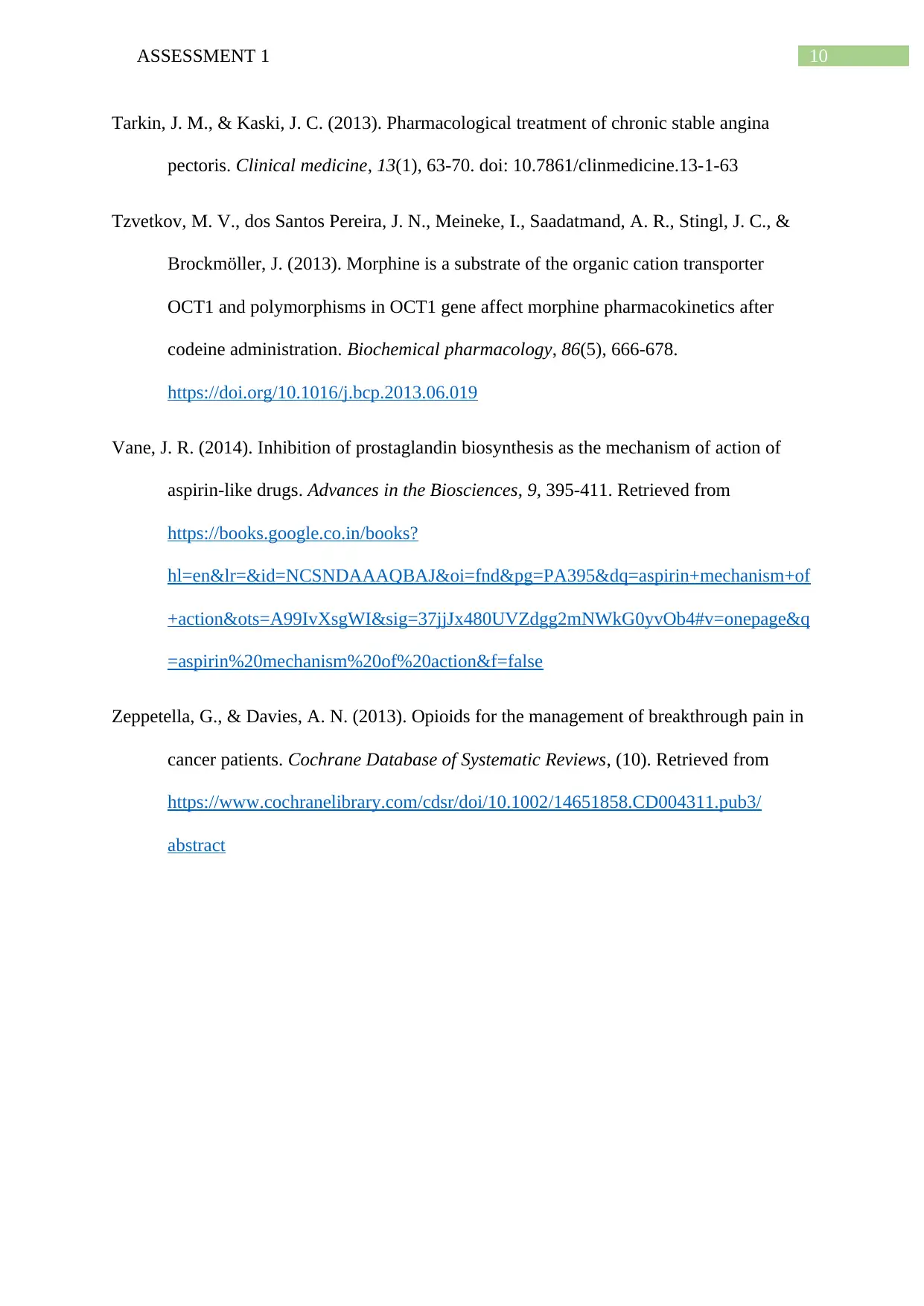
10ASSESSMENT 1
Tarkin, J. M., & Kaski, J. C. (2013). Pharmacological treatment of chronic stable angina
pectoris. Clinical medicine, 13(1), 63-70. doi: 10.7861/clinmedicine.13-1-63
Tzvetkov, M. V., dos Santos Pereira, J. N., Meineke, I., Saadatmand, A. R., Stingl, J. C., &
Brockmöller, J. (2013). Morphine is a substrate of the organic cation transporter
OCT1 and polymorphisms in OCT1 gene affect morphine pharmacokinetics after
codeine administration. Biochemical pharmacology, 86(5), 666-678.
https://doi.org/10.1016/j.bcp.2013.06.019
Vane, J. R. (2014). Inhibition of prostaglandin biosynthesis as the mechanism of action of
aspirin-like drugs. Advances in the Biosciences, 9, 395-411. Retrieved from
https://books.google.co.in/books?
hl=en&lr=&id=NCSNDAAAQBAJ&oi=fnd&pg=PA395&dq=aspirin+mechanism+of
+action&ots=A99IvXsgWI&sig=37jjJx480UVZdgg2mNWkG0yvOb4#v=onepage&q
=aspirin%20mechanism%20of%20action&f=false
Zeppetella, G., & Davies, A. N. (2013). Opioids for the management of breakthrough pain in
cancer patients. Cochrane Database of Systematic Reviews, (10). Retrieved from
https://www.cochranelibrary.com/cdsr/doi/10.1002/14651858.CD004311.pub3/
abstract
Tarkin, J. M., & Kaski, J. C. (2013). Pharmacological treatment of chronic stable angina
pectoris. Clinical medicine, 13(1), 63-70. doi: 10.7861/clinmedicine.13-1-63
Tzvetkov, M. V., dos Santos Pereira, J. N., Meineke, I., Saadatmand, A. R., Stingl, J. C., &
Brockmöller, J. (2013). Morphine is a substrate of the organic cation transporter
OCT1 and polymorphisms in OCT1 gene affect morphine pharmacokinetics after
codeine administration. Biochemical pharmacology, 86(5), 666-678.
https://doi.org/10.1016/j.bcp.2013.06.019
Vane, J. R. (2014). Inhibition of prostaglandin biosynthesis as the mechanism of action of
aspirin-like drugs. Advances in the Biosciences, 9, 395-411. Retrieved from
https://books.google.co.in/books?
hl=en&lr=&id=NCSNDAAAQBAJ&oi=fnd&pg=PA395&dq=aspirin+mechanism+of
+action&ots=A99IvXsgWI&sig=37jjJx480UVZdgg2mNWkG0yvOb4#v=onepage&q
=aspirin%20mechanism%20of%20action&f=false
Zeppetella, G., & Davies, A. N. (2013). Opioids for the management of breakthrough pain in
cancer patients. Cochrane Database of Systematic Reviews, (10). Retrieved from
https://www.cochranelibrary.com/cdsr/doi/10.1002/14651858.CD004311.pub3/
abstract
1 out of 11
Related Documents
Your All-in-One AI-Powered Toolkit for Academic Success.
+13062052269
info@desklib.com
Available 24*7 on WhatsApp / Email
![[object Object]](/_next/static/media/star-bottom.7253800d.svg)
Unlock your academic potential
Copyright © 2020–2025 A2Z Services. All Rights Reserved. Developed and managed by ZUCOL.





